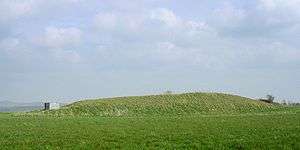Long barrow
A long barrow is a prehistoric monument usually dating to the early Neolithic period, traditionally interpreted as a collective tomb. They are rectangular or trapezoidal tumuli or earth mounds. Long barrows are also typical of several Celtic, Slavic, and Baltic cultures of Northern Europe of the 1st millennium AD.

Long barrows in the United Kingdom
50% of the long barrows in Gloucestershire, 66% in Hampshire, 80% in Lincolnshire and almost all the burial mounds in Essex have been damaged. According to English Heritage modern tillage techniques have done as much damage in the last six decades as traditional tilling did in six centuries.[1]

Function
The function of long barrows is not known. They contain bones of many individuals, which often show evidence of regular moving around or sorting. It appears they were accessed regularly, not just to inter newly deceased bodies but also to make use of the old bones there. Possibly bones were taken out of the barrow for some purpose and returned later. Some authors speculate that this was part of an ancestor veneration practice, perhaps similar to the present-day Famadihana tradition found in Madagasgar.
See also
Line notes
- ↑ http://www.english-heritage.org.uk/publications/ripping-up-history-archaeology-under-the-plough/030725rippinguphistory.pdf/ July 2003 English Heritage - Ripping Up History
References and further reading
- Ashbee, Paul (1984). The Earthen Long Barrow in Britain: An Introduction to the Study of the Funerary Practice and Culture of the Neolithic People of the Third Millennium B.C. Geo Books. ISBN 0-86094-170-1.
- Darvill, Timothy (2004). Long Barrows of the Cotswolds and surrounding areas. Tempus Publishing. ISBN 0-7524-2907-8.
- Lynch, Frances (1997). Megalithic Tombs and Long Barrows in Britain. Shire Publications Ltd. ISBN 0-7478-0341-2.
- Hodder I, 1984, Burials, houses, women and men in the European Neolithic in D Miller and C Tilley (eds), Architecture and Order, Oxford, Basil Blackwell
- Knight, Peter, 2011, West Kennet Long Barrow: Landscape, Shamans and the Cosmos, Stone Seeker Publishing
- Russell, M, 2004 The treachery of images: deconstructing the early Neolithic monumental architecture of the South Downs in Cotton, J and Field, D (eds) Towards a New Stone Age, CBA Research Report 137, York, Council for British Archaeology